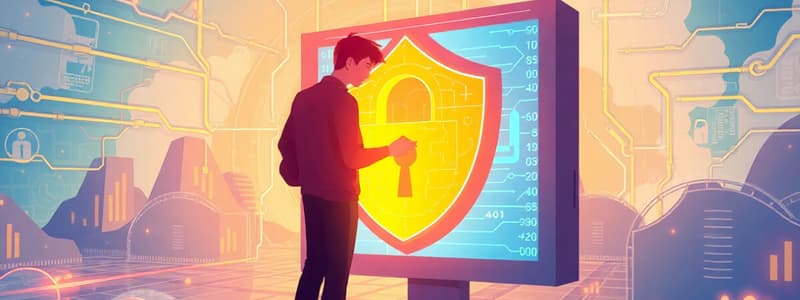Podcast
Questions and Answers
Which of the following is a primary purpose of social engineering in computer security?
Which of the following is a primary purpose of social engineering in computer security?
- Manipulating human psychology (correct)
- Creating security policies
- Enhancing encryption methods
- Bypassing technical security measures
What is the main function of a security policy in a computer security context?
What is the main function of a security policy in a computer security context?
- To encrypt sensitive data during transmission
- To identify potential security threats
- To define what is allowed and enforce security mechanisms (correct)
- To analyze network traffic in real-time
What is the primary focus of computer security?
What is the primary focus of computer security?
- Monitoring user behavior
- Preventing software installation
- Securing a single connected machine (correct)
- Protecting communication between computers
Which of the following is NOT considered a computer security threat?
Which of the following is NOT considered a computer security threat?
Caesar's Cipher is an example of what type of cryptographic technique?
Caesar's Cipher is an example of what type of cryptographic technique?
What does the concept of 'availability' in computer security refer to?
What does the concept of 'availability' in computer security refer to?
Which of the following is considered an insider threat?
Which of the following is considered an insider threat?
What is the role of checksums in data transmission?
What is the role of checksums in data transmission?
Which of the following mechanisms helps prevent break-ins to a system?
Which of the following mechanisms helps prevent break-ins to a system?
What is considered a common cause of security vulnerabilities in software?
What is considered a common cause of security vulnerabilities in software?
Which of the following best describes 'spoofing' in the context of computer security?
Which of the following best describes 'spoofing' in the context of computer security?
What is a critical reason a computer network might remain insecure after configuration changes?
What is a critical reason a computer network might remain insecure after configuration changes?
Which option describes network security effectively?
Which option describes network security effectively?
Which mechanism is essential for verifying the truth of claimed data?
Which mechanism is essential for verifying the truth of claimed data?
How can malicious emails impact a computer system?
How can malicious emails impact a computer system?
Which of the following actions does NOT contribute to computer security?
Which of the following actions does NOT contribute to computer security?
What is the primary function of authorization in computer security?
What is the primary function of authorization in computer security?
Which mechanism is specifically designed to protect against unauthorized access from external sources?
Which mechanism is specifically designed to protect against unauthorized access from external sources?
What does a Virtual Private Network (VPN) primarily provide?
What does a Virtual Private Network (VPN) primarily provide?
What is the role of Internet Protocol Security (IPSec)?
What is the role of Internet Protocol Security (IPSec)?
Which security mechanism helps establish encrypted links between web servers and browsers?
Which security mechanism helps establish encrypted links between web servers and browsers?
What is the purpose of an Intrusion Detection System (IDS)?
What is the purpose of an Intrusion Detection System (IDS)?
Which of the following is NOT a characteristic of a firewall?
Which of the following is NOT a characteristic of a firewall?
What is the main advantage of using virus scanners?
What is the main advantage of using virus scanners?
Flashcards
Computer Security
Computer Security
Protecting a single computer from unauthorized access, attacks, information theft, and misuse.
Network Security
Network Security
Protecting communication networks and all the devices connected to them from unauthorized access, attacks, and data breaches.
Breaking into my computer
Breaking into my computer
Unauthorized access to a computer system, often with the intent to steal information, cause damage, or disrupt operations. Examples include hackers, viruses, and worms.
Attacking my computer
Attacking my computer
Signup and view all the flashcards
Stealing an information
Stealing an information
Signup and view all the flashcards
Using my computer to attack others
Using my computer to attack others
Signup and view all the flashcards
Damaging my computer or data
Damaging my computer or data
Signup and view all the flashcards
Taking up the resources with irrelevant messages
Taking up the resources with irrelevant messages
Signup and view all the flashcards
Authorization
Authorization
Signup and view all the flashcards
Firewall
Firewall
Signup and view all the flashcards
VPN (Virtual Private Network)
VPN (Virtual Private Network)
Signup and view all the flashcards
IPsec (Internet Protocol Security)
IPsec (Internet Protocol Security)
Signup and view all the flashcards
SSL (Secure Sockets Layer)
SSL (Secure Sockets Layer)
Signup and view all the flashcards
Virus Scanner
Virus Scanner
Signup and view all the flashcards
Intrusion Detection System (IDS)
Intrusion Detection System (IDS)
Signup and view all the flashcards
Access Control
Access Control
Signup and view all the flashcards
Caesar's Cipher
Caesar's Cipher
Signup and view all the flashcards
Social Engineering
Social Engineering
Signup and view all the flashcards
Insider Threat
Insider Threat
Signup and view all the flashcards
Security Policy
Security Policy
Signup and view all the flashcards
Security Mechanism
Security Mechanism
Signup and view all the flashcards
Encryption
Encryption
Signup and view all the flashcards
Checksum
Checksum
Signup and view all the flashcards
Authentication
Authentication
Signup and view all the flashcards
Study Notes
Computer Security Overview
- Computer security encompasses protecting computing transactions from unauthorized access, attacks, data theft, damage to resources, and misuse.
- Key areas of concern include network security and computer security.
What's Ahead?
- Understanding basic computer security concepts
- Identifying common security threats
- Understanding the role of policy in computer security
- Identifying computer security mechanisms
What Does Security Mean?
- Security means preventing unauthorized access, attacks, and data theft on computer systems and networks. This includes preventing damage to computer resources and data without explicit permission.
Computer vs. Network Security
- Computer security protects a single machine, while network security safeguards communication and all participating entities within a network.
Computer Security Threats
- Breaking into a computer: Hacking, worms, and viruses.
- Attacking a computer: Denial-of-service attacks, viruses, and worms.
- Stealing information: Data breaches and various forms of hacking and malicious software.
- Using a computer to attack others: Spam, phishing, and email/malware-based attacks.
Damaging Computer Systems
- Tampering and altering data through various means, often employing cryptography for detection. Duplicating data for recovery from damage.
Taking up Resources
- Denial-of-service attacks; spam mail that fills space; malicious mail containing viruses and worms.
Aspects of Computer Security
- Confidentiality: Data secrecy from unauthorized users.
- Integrity: Data accuracy and preventing modifications.
- Availability: System accessibility and functionality.
Why We Aren't Secure (Causes of Vulnerabilities)
- Buggy code: Unvalidated input, cross-site scripting, buffer overflow, flawed injection methods.
- Protocol design failures: Weaknesses in protocols governing data handling, leading to vulnerabilities.
- Weak cryptography: Poor cryptographic procedures offering inadequate authentication, integrity protection, and non-repudiation.
- Social engineering: Exploiting human psychology for gaining unauthorized system access.
- Insider threats: Security vulnerabilities arising from within an organization, often through employee or officer actions.
- Poor configuration: System flaws arising from inadequate adaptation to new tasks and user requests.
- Incorrect policy specification: Misaligned or flawed policies with security implications.
- Stolen keys/identities: Unauthorized access due to compromised credentials or identities.
- Misplaced incentives: System breach opportunities caused by misleading user incentives, a technique called spoofing, or similar challenges. Examples include email, URL, caller ID spoofing to gain unauthorized access.
The Role of Policy
- Policies define allowed system actions and mechanisms for enforcement. Policies are interpreted and enforced by software/tools like firewalls and intrusion detection systems (IDS), as well as access control lists. Correct and secure implementation is crucial.
Some Security Mechanisms
- Encryption: Encoding data to conceal its contents, using cryptographic keys and algorithms.
- Checksums: Data integrity checks (hashes) used to detect unauthorized modifications. This involves sending encoded checksums along with the message/data to help verify integrity.
- Authentication: Verifying the identity of a user or system entity.
- Authorization: Determining the privileges/access levels for authenticated entities regarding system resources and data/functionality permissions.
- Firewalls: Blocking unauthorized network access.
- VPNs (Virtual Private Networks): Securing data transmissions across public networks.
- Intrusion Detection Systems (IDS): Systems that monitor network or system activities for malicious actions.
- Virus scanners: Software scanning systems and their content for harmful programs.
Today's Security Deployment
- Firewalls: Blocking unauthorized access from exterior and maintaining secure communications channels.
- VPNs: Creating secure tunnels for internet connections ensuring data protections.
- IPSec: A framework for secure communications over IP networks using cryptography.
- SSL (Secure Sockets Layer): A protocol establishing encrypted channels for web communication.
- IDS (Intrusion Detection Systems): Monitoring networks and individual systems for malicious actions and policy violations. Protecting against data intrusions and vulnerabilities.
Studying That Suits You
Use AI to generate personalized quizzes and flashcards to suit your learning preferences.





